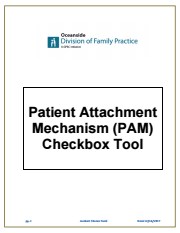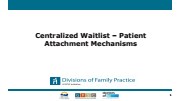939 public records – page 1 of 47. — Log in to view all records
Recruitment and Retention: A Conversation with The Next Generation of Family Doctors - Presentation
https://www.jcc-resourcecatalogue.ca/en/permalink/divisionresource1111
- Published Date
- 2018-04-17
- Description
- "A presentation from the GPSC Summit 2018. The presentation gives an overview of the Recruitment and Retention Steering Committee's work."
- Corporate Author
- General Practice Services Committee
- Doctors of BC
- Ministry of Health
- Personal Author
- Dr Aaron Childs
- Published Date
- 2018-04-17
- Topics
- Recruitment and Retention
- Locums
- Event
- GPSC Summit 2018
- Workshop
- Recruitment and Retention: A Conversation with The Next Generation of Family Doctors
- Resource Type
- Presentation
- File Type
- PowerPoint
- Description
- A presentation from the GPSC Summit 2018. The presentation gives an overview of the Recruitment and Retention Steering Committee's work.
Recruitment and Retention: A Conversation with The Next Generation of Family Doctors- Primary Care Plus - Presentation
https://www.jcc-resourcecatalogue.ca/en/permalink/divisionresource1112
- Health Authority
- Island
- Division
- Nanaimo Division of Family Practice
- Published Date
- 2018-04-17
- Description
- "A presentation from the GPSC Summit 2018 on the Nanaimo DoFP's work to improve Primary Care."
- Health Authority
- Island
- Division
- Nanaimo Division of Family Practice
- Corporate Author
- Nanaimo Division of Family Practice
- Personal Author
- Dr Derek Poteryko Dr Danielle Downe Dr Shelly Chopra
- Published Date
- 2018-04-17
- Topics
- Primary Care
- Patient-Centred Care
- Event
- GPSC Summit 2018
- Workshop
- Recruitment and Retention: A Conversation with The Next Generation of Family Doctors
- Resource Type
- Presentation
- File Type
- PowerPoint
- Description
- A presentation from the GPSC Summit 2018 on the Nanaimo DoFP's work to improve Primary Care.
Building Blocks for Maternity Care - Presentation
https://www.jcc-resourcecatalogue.ca/en/permalink/divisionresource1113
- Health Authority
- Fraser
- Interior
- Division
- Burnaby Division of Family Practice
- Kootenay Boundary Division of Family Practice
- White Rock South Surrey Division of Family Practice
- Published Date
- 2018-04-17
- Description
- "A presentation from the GPSC Summit 2018 on the several initiatives that are improving maternity care for providers and patients."
- Health Authority
- Fraser
- Interior
- Division
- Burnaby Division of Family Practice
- Kootenay Boundary Division of Family Practice
- White Rock South Surrey Division of Family Practice
- Corporate Author
- General Practice Services Committee
- Burnaby Division of Family Practice
- Kootenay Boundary Division of Family Practice
- White Rock South Surrey Division of Family Practice
- Personal Author
- Dr Shelley Ross Nancy Falconer Kim Williams Dr Charlene Lui Dr Marvin Lemke Dr Jeanette Boyd Dr Tahmeena Ali Dr Karen Buhler
- Published Date
- 2018-04-17
- Event
- GPSC Summit 2018
- Workshop
- Building Blocks for Maternity Care
- Resource Type
- Presentation
- File Type
- Description
- A presentation from the GPSC Summit 2018 on the several initiatives that are improving maternity care for providers and patients.
Nurses in Primary Care: Four Experiences Across BC - Pre-Session Reading Material
https://www.jcc-resourcecatalogue.ca/en/permalink/divisionresource1114
- Health Authority
- Fraser
- Interior
- Vancouver Coastal
- Division
- Central Okanagan Division of Family Practice
- Powell River Division of Family Practice
- Kootenay Boundary Division of Family Practice
- White Rock South Surrey Division of Family Practice
- Published Date
- 2018-04-17
- Description
- "A pre-reading summary of the Nurses in Primary Care: Four Experiences Across BC session at the GPSC Summit 2018."
- Health Authority
- Fraser
- Interior
- Vancouver Coastal
- Division
- Central Okanagan Division of Family Practice
- Powell River Division of Family Practice
- Kootenay Boundary Division of Family Practice
- White Rock South Surrey Division of Family Practice
- Corporate Author
- General Practice Services Committee
- Published Date
- 2018-04-17
- Event
- GPSC Summit 2018
- Workshop
- Nurses in Primary Care: Four Experiences Across BC
- Resource Type
- Summary
- File Type
- Description
- A pre-reading summary of the Nurses in Primary Care: Four Experiences Across BC session at the GPSC Summit 2018.
Nurses in Primary Care: Four Experiences Across BC - Presentation
https://www.jcc-resourcecatalogue.ca/en/permalink/divisionresource1115
- Published Date
- 2018-04-17
- Link to File
- /media/divresources/Nurses_Scopes_and_PMH.pptx
- Description
- "A presentation from the GPSC Summit 2018 describing the various categories of nursing."
- Corporate Author
- Island Health
- Personal Author
- Rosemary Graham
- Published Date
- 2018-04-17
- Topics
- Nurse
- Nurse Practitioners
- Event
- GPSC Summit 2018
- Workshop
- Nurses in Primary Care: Four Experiences Across BC
- Resource Type
- Presentation
- File Type
- PowerPoint
- Link to File
- /media/divresources/Nurses_Scopes_and_PMH.pptx
- Description
- A presentation from the GPSC Summit 2018 describing the various categories of nursing.
Who's in Charge? Governance in Alberta's Primary Care Network - Alberta's Presentation
https://www.jcc-resourcecatalogue.ca/en/permalink/divisionresource1116
- Published Date
- 2018-04-16
- Description
- "A presentation from the GPSC Summit 2018 on Alberta's past, and current model of governance, the lessons they had learned that necessitated the change, and their recognition of strong physician leadership."
- Corporate Author
- Alberta Medical Association
- Personal Author
- Dr Phillip van der Merwe Grant Sorochan
- Published Date
- 2018-04-16
- Event
- GPSC Summit 2018
- Workshop
- Who’s in Charge? Governance in Alberta’s Primary Care Network
- Resource Type
- Presentation
- File Type
- PowerPoint
- Description
- A presentation from the GPSC Summit 2018 on Alberta's past, and current model of governance, the lessons they had learned that necessitated the change, and their recognition of strong physician leadership.
GPSC Summit 2018 Event Summary
https://www.jcc-resourcecatalogue.ca/en/permalink/divisionresource1117
- Published Date
- 2018-05-14
- Link to File
- /media/divresources/GPSC_Summit_Summary.pdf
- Description
- "The event summary from the GPSC Summit 2018. This document captures the highlights of the event, and finishes with a message from the GPSC Co-chairs about the future of primary care in BC."
- Corporate Author
- General Practice Services Committee
- Published Date
- 2018-05-14
- Event
- GPSC Summit 2018
- Resource Type
- Summary
- File Type
- Link to File
- /media/divresources/GPSC_Summit_Summary.pdf
- Description
- The event summary from the GPSC Summit 2018. This document captures the highlights of the event, and finishes with a message from the GPSC Co-chairs about the future of primary care in BC.
Blue Sky Clinic Building - Primary Care Plus - Webinar Presentation
https://www.jcc-resourcecatalogue.ca/en/permalink/divisionresource1118
- Health Authority
- Island
- Division
- Nanaimo Division of Family Practice
- Published Date
- 2018-06-19
- Link to File
- /media/divresources/PrimaryCareAwakens.pdf
- Description
- "A presentation from the Primary Care Awakens - Blue Sky Clinic Model Webinar on a new model of care designed to inspire engagement of early career family physicians into full service family practice."
- Health Authority
- Island
- Division
- Nanaimo Division of Family Practice
- Personal Author
- Dr Derek Poteryko, Dr Danielle Downe, Dr Shelly Chopra
- Published Date
- 2018-06-19
- Event
- Primary Care Awakens - Blue Sky Clinic Model Webinar
- Resource Type
- Presentation
- File Type
- Link to File
- /media/divresources/PrimaryCareAwakens.pdf
- Description
- A presentation from the Primary Care Awakens - Blue Sky Clinic Model Webinar on a new model of care designed to inspire engagement of early career family physicians into full service family practice.
In Search of Joy in Practice: A Report of 23 High-Functioning Primary Care Practices - Article
https://www.jcc-resourcecatalogue.ca/en/permalink/divisionresource1119
- Published Date
- 2018-06-19
- Description
- "A supporting document to the presentation made during the Primary Care Awakens - Blue Sky Clinic Model Webinar. It highlights the Primary Care innovations gathered from high-functioning Primary Care practices believed to facilitate joy in practice and mitigate physician burnout."
- Personal Author
- Dr Christine A. Sinsky, Rachel Willard-Grace, Dr Andrew M. Schutzbank, Dr Thomas A. Sinsky, Dr David Margolius, Dr Thomas Bodenheimer.
- Published Date
- 2018-06-19
- Event
- Primary Care Awakens - Blue Sky Clinic Model Webinar
- Resource Type
- Article
- File Type
- Web page
- Originating web page
- http://www.annfammed.org/content/11/3/272.full
- Publisher
- Annals of Family Medicine
- Citation
- Sinsky CA, Willard-Grace R, Schutzbank AM, Sinsky TA, Margolius D, Bodenheimer T. In search of joy in practice: a report of 23 high-functioning primary care practices. Ann Fam Med. 2013. Online
- Description
- A supporting document to the presentation made during the Primary Care Awakens - Blue Sky Clinic Model Webinar. It highlights the Primary Care innovations gathered from high-functioning Primary Care practices believed to facilitate joy in practice and mitigate physician burnout.
The 10 Building Blocks of High-Performing Primary Care - Article
https://www.jcc-resourcecatalogue.ca/en/permalink/divisionresource1120
- Published Date
- 2018-06-19
- Description
- "A supporting article to the presentation made during the Primary Care Awakens - Blue Sky Clinic Model Webinar. It highlights the essential elements of primary care, which are called the 10 building blocks of high-performing primary care."
- Personal Author
- Dr Thomas Bodenheimer, Amireh Ghorob, Rachel Willard-Grace, Dr Kevin Grumbach
- Published Date
- 2018-06-19
- Event
- Primary Care Awakens - Blue Sky Clinic Model Webinar
- Resource Type
- Article
- File Type
- Web page
- Originating web page
- http://www.annfammed.org/content/12/2/166.full
- Publisher
- Annals of Family Medicine
- Citation
- Bodenheimer T, Ghorob A, Willard-Grace R, Grumbach K. The 10 building blocks of high-performing primary care. Ann Fam Med 2014. Online.
- Description
- A supporting article to the presentation made during the Primary Care Awakens - Blue Sky Clinic Model Webinar. It highlights the essential elements of primary care, which are called the 10 building blocks of high-performing primary care.
Perceived Barriers to Full-Service Family Practice: A Survey of Family Practice Residents (UBC, Nanaimo Site) - Project
https://www.jcc-resourcecatalogue.ca/en/permalink/divisionresource1121
- Health Authority
- Island
- Division
- Nanaimo Division of Family Practice
- Published Date
- 2018-06-19
- Description
- "A supporting project to the Primary Care Awakens - Blue Sky Clinic Model Webinar about the perceived barriers preventing graduates from entering full service family practice."
- Health Authority
- Island
- Division
- Nanaimo Division of Family Practice
- Corporate Author
- University of British Columbia (UBC)
- Personal Author
- Dr Jesse Wolfe, Dr Christopher Yeker
- Published Date
- 2018-06-19
- Topics
- Primary Care
- Residents
- Event
- Primary Care Awakens - Blue Sky Clinic Model Webinar
- Resource Type
- Report
- File Type
- Description
- A supporting project to the Primary Care Awakens - Blue Sky Clinic Model Webinar about the perceived barriers preventing graduates from entering full service family practice.
Primary Care Awakens - Blue Sky Clinic Model - Webinar Recording
https://www.jcc-resourcecatalogue.ca/en/permalink/divisionresource1122
- Health Authority
- Island
- Division
- Nanaimo Division of Family Practice
- Published Date
- 2018-06-19
- Description
- "The recording of the Primary Care Awakens - Blue Sky Clinic Model Webinar."
- Health Authority
- Island
- Division
- Nanaimo Division of Family Practice
- Corporate Author
- Nanaimo Division of Family Practice
- General Practice Services Committee
- Published Date
- 2018-06-19
- Event
- Primary Care Awakens - Blue Sky Clinic Model Webinar
- Resource Type
- Audio Recording
- Video Recording
- File Type
- Web page
- Originating web page
- https://register.gotowebinar.com/recording/571497948369817347
- Recording Length
- 58mins 7secs
- Description
- The recording of the Primary Care Awakens - Blue Sky Clinic Model Webinar.
National Interprofessional Competency Framework
https://www.jcc-resourcecatalogue.ca/en/permalink/divisionresource1123
- Published Date
- 2010-02
- Link to File
- /media/divresources/Gilbert(2010)_A_national_interprofessional_competency_framework.pdf
- Description
- "This quick reference guide outlines key competencies needed to build effective health care teams and improve the experience and outcomes of patients."
- Corporate Author
- Canadian Interprofessional Health Collaborative
- Published Date
- 2010-02
- Resource Type
- Guidelines
- File Type
- Link to File
- /media/divresources/Gilbert(2010)_A_national_interprofessional_competency_framework.pdf
- Originating web page
- http://tools.hhr-rhs.ca/index.php?option=com_mtree&task=viewlink&link_id=7095&Itemid=109&lang=en
- Description
- This quick reference guide outlines key competencies needed to build effective health care teams and improve the experience and outcomes of patients.
Saanich Peninsula Primary Health Care Society (SPPHCS) - Model of Primary Health Care
https://www.jcc-resourcecatalogue.ca/en/permalink/divisionresource1124
- Published Date
- 2016
- Description
- "This report describes a model of primary health care including stepped care and an interdisciplinary safety net."
- Corporate Author
- Saanich Peninsula Primary Health Care Society (SPPHCS)
- Published Date
- 2016
- Resource Type
- Report
- File Type
- Word
- Description
- This report describes a model of primary health care including stepped care and an interdisciplinary safety net.
Centralized Waitlist - Patient Attachment Mechanisms - Webinar Recording
https://www.jcc-resourcecatalogue.ca/en/permalink/divisionresource1125
- Health Authority
- Fraser
- Interior
- Island
- Division
- Chilliwack Division of Family Practice
- Oceanside Division of Family Practice
- Thompson Region Division of Family Practice
- Published Date
- 2018-07-10
- Description
- "The recording of the Centralized Waitlist- Patient Attachment Mechanisms webinar."
- Health Authority
- Fraser
- Interior
- Island
- Division
- Chilliwack Division of Family Practice
- Oceanside Division of Family Practice
- Thompson Region Division of Family Practice
- Corporate Author
- General Practice Services Committee
- Ministry of Health
- HealthLinkBC
- Published Date
- 2018-07-10
- Topics
- Attachment
- Event
- Centralized Waitlist- Patient Attachment Mechanisms Webinar
- Resource Type
- Video Recording
- Audio Recording
- File Type
- Web page
- Originating web page
- https://attendee.gotowebinar.com/recording/4406307534005573122
- Recording Length
- 1hr 27mins 19secs
- Description
- The recording of the Centralized Waitlist- Patient Attachment Mechanisms webinar.
Patient Attachment Mechanism (PAM) Checkbox Tool - Process Document
https://www.jcc-resourcecatalogue.ca/en/permalink/divisionresource1126
- Health Authority
- Island
- Division
- Oceanside Division of Family Practice
- Published Date
- 2018-07-10
- Description
- "A descriptive document on Oceanside Division of Family Practice's implementation of their Patient Attachment Mechanism."
- Health Authority
- Island
- Division
- Oceanside Division of Family Practice
- Personal Author
- Sharon Todd
- Published Date
- 2018-07-10
- Topics
- Attachment
- Event
- Centralized Waitlist - Patient Attachment Mechanisms Webinar
- Resource Type
- Process Document
- File Type
- Description
- A descriptive document on Oceanside Division of Family Practice's implementation of their Patient Attachment Mechanism.
Centralized Waitlist – Patient Attachment Mechanisms - Presentation
https://www.jcc-resourcecatalogue.ca/en/permalink/divisionresource1127
- Health Authority
- Interior
- Fraser
- Division
- Chilliwack Division of Family Practice
- Thompson Region Division of Family Practice
- Published Date
- 2018-07-10
- Link to File
- /media/divresources/Centralized_Waitlist_PAM.pdf
- Description
- "The presentation slides from the Centralized Waitlist - Patient Attachment Mechanisms webinar."
- Health Authority
- Interior
- Fraser
- Division
- Chilliwack Division of Family Practice
- Thompson Region Division of Family Practice
- Corporate Author
- Doctors of BC
- Ministry of Health
- HealthLinkBC
- Published Date
- 2018-07-10
- Topics
- Attachment
- Event
- Centralized Waitlist - Patient Attachment Mechanisms Webinar
- Resource Type
- Presentation
- File Type
- Link to File
- /media/divresources/Centralized_Waitlist_PAM.pdf
- Description
- The presentation slides from the Centralized Waitlist - Patient Attachment Mechanisms webinar.
Patient Attachment Mechanisms - Thompson Region - Presentation
https://www.jcc-resourcecatalogue.ca/en/permalink/divisionresource1128
- Health Authority
- Interior
- Division
- Thompson Region Division of Family Practice
- Published Date
- 2018-07-10
- Description
- "The Thompson Region Division of Family Practice's presentation surrounding their patient attachment mechanism."
- Health Authority
- Interior
- Division
- Thompson Region Division of Family Practice
- Corporate Author
- Thompson Region Division of Family Practice
- Published Date
- 2018-07-10
- Topics
- Attachment
- Event
- Centralized Waitlist - Patient Attachment Mechanisms Webinar
- Resource Type
- Presentation
- File Type
- Description
- The Thompson Region Division of Family Practice's presentation surrounding their patient attachment mechanism.
Sample Medical Office Assistant Job Description
https://www.jcc-resourcecatalogue.ca/en/permalink/divisionresource1129
- Program
- Divisions of Family Practice
- Link to File
- https://divisionsbc.ca/sites/default/files/Divisions/Provincial/MOA%20Job%20Description.pdf
- Description
- "This job description for a Medical Office Assistant can be used as a template."
- Program
- Divisions of Family Practice
- Corporate Author
- General Practice Services Committee
- Topics
- PMH Attributes: TBC Toolkit - Understanding TBC
- Team-Based Care
- Human Resources
- MOAs
- Patient Medical Home
- Resource Type
- Job Description
- File Type
- Web page
- Link to File
- https://divisionsbc.ca/sites/default/files/Divisions/Provincial/MOA%20Job%20Description.pdf
- Originating web page
- https://www.divisionsbc.ca/provincial/resources/practice-toolkit/appendices
- Description
- This job description for a Medical Office Assistant can be used as a template.
Sample Practice Manager Job Description
https://www.jcc-resourcecatalogue.ca/en/permalink/divisionresource1130
- Program
- Divisions of Family Practice
- Description
- "This job description for a Practice Manager can be used as a template."
- Program
- Divisions of Family Practice
- Corporate Author
- General Practice Services Committee
- Topics
- PMH Attributes: TBC Toolkit - Understanding TBC
- Team-Based Care
- Human Resources
- Patient Medical Home
- Resource Type
- Job Description
- File Type
- Web page
- Originating web page
- https://www.divisionsbc.ca/provincial/resources/practice-toolkit/appendices
- Description
- This job description for a Practice Manager can be used as a template.







_A_national_interprofessional_competency_framework.pdf?width=180&404=no-img.jpg)


